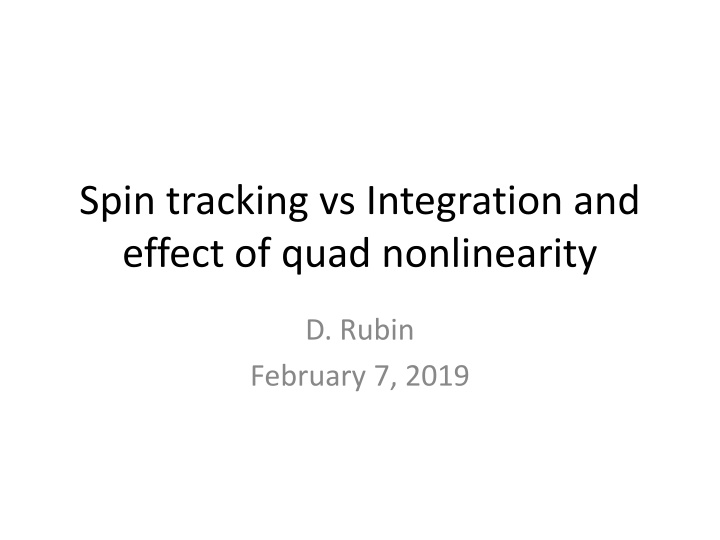
Spin Tracking, Integration, and Effects of Quadrupole Nonlinearity
Delve into the world of spin tracking, integration, and the impact of quadrupole nonlinearity in particle physics. Explore methods for pitch correction, amplitude measurement, and dealing with quad nonlinearity in simulations. Discover how to address amplitude dependence and tune, and compare different methods for analyzing spin tracking and integration reliability.
Download Presentation

Please find below an Image/Link to download the presentation.
The content on the website is provided AS IS for your information and personal use only. It may not be sold, licensed, or shared on other websites without obtaining consent from the author. If you encounter any issues during the download, it is possible that the publisher has removed the file from their server.
You are allowed to download the files provided on this website for personal or commercial use, subject to the condition that they are used lawfully. All files are the property of their respective owners.
The content on the website is provided AS IS for your information and personal use only. It may not be sold, licensed, or shared on other websites without obtaining consent from the author.
E N D
Presentation Transcript
Spin tracking vs Integration and effect of quad nonlinearity D. Rubin February 7, 2019
Pitch systematic y0 By 2/7/19 D. Rubin
Pitch correction 3 ways to compute pitch correction in simulation Spin tracking Includes everything, but ppb precision requires many turns Integration along trajectory very good approximation far from resonances Measurement of vertical amplitude assumes quad linearity 2/7/19 D. Rubin
Spin tracking using BMT Pitch correction vs vertical amplitude 2/7/19 D. Rubin
Spin tracking and integration are in good agreement 2/7/19 D. Rubin
Vertical amplitude (y0)/ v is not a good measure of angle at large amplitude 2/7/19 D. Rubin
Quad nonlinearity => amplitude dependence of tune and And nonlinear dependence of on y0 2/7/19 D. Rubin
We can correct for the amplitude dependence by measuring the vertical tune Alternatively, measure the angular distribution directly 2/7/19 D. Rubin
2/7/19 D. Rubin
Some equations Only Ergives first-order contribution to the precession along the vertical direction: E field correction 3 ways to compute E-field contribution to 1. Spin tracking (BMT equation) 2. Integration a) Integration along trajectory (includes betatron oscillations) b) Integration along closed orbit ( ) Note that method 2b) is most nearly equivalent to the classic method, namely p c p 0 0 2 e x 2 2 (1 ) C n n E a 2 r 0 Compare the 3 methods in simulation to determine 1. If integration is a reliable proxy for spin tracking 2. The size of the contribution from finite betatron oscillation amplitude 3. Effect of quad nonlinearity 2/7/19 D. Rubin
Distinct trajectories with common momentum offset - For trajectory compute a by spin tracking and by integration Is the Efield correction independent of the betatron amplitude? 2/7/19 D. Rubin
Multiple points at each momentum correspond to different betatron amplitudes The spread at momentum zero is a measure of the accuracy of the simulation (since the E-field correction is nominally zero at the magic momentum) 2/7/19 D. Rubin
Efield correction computed with spin tracking in good agreement with correction based on 2/7/19 D. Rubin
along the trajectory is very nearly the same as along the closed orbit. (There is little dependence on betatron amplitude) 2/7/19 D. Rubin
2/7/19 D. Rubin
The calculation of the E-field correction that assumes quad linearity, overestimates the effect at large momentum offset (where E-field does not increase linearly with displacement) 2/7/19 D. Rubin
Replace n, R0 and with Qx and measure Qx for each momentum => The effect of quad nonlinearity can be corrected by measuring momentum dependence of horizontal tune 2/7/19 D. Rubin
2/7/19 D. Rubin
2/7/19 D. Rubin
Comments Quad fields are based on an azimuthal slice of 3-D field map with no end effect details And perfect relative alignment of plates and absolute alignment about magic radius Perfect B-field Measurement of amplitude/momentum dependence of tunes would be very useful to diagnose quad fields and compensate nonlinearities. 2/7/19 D. Rubin
